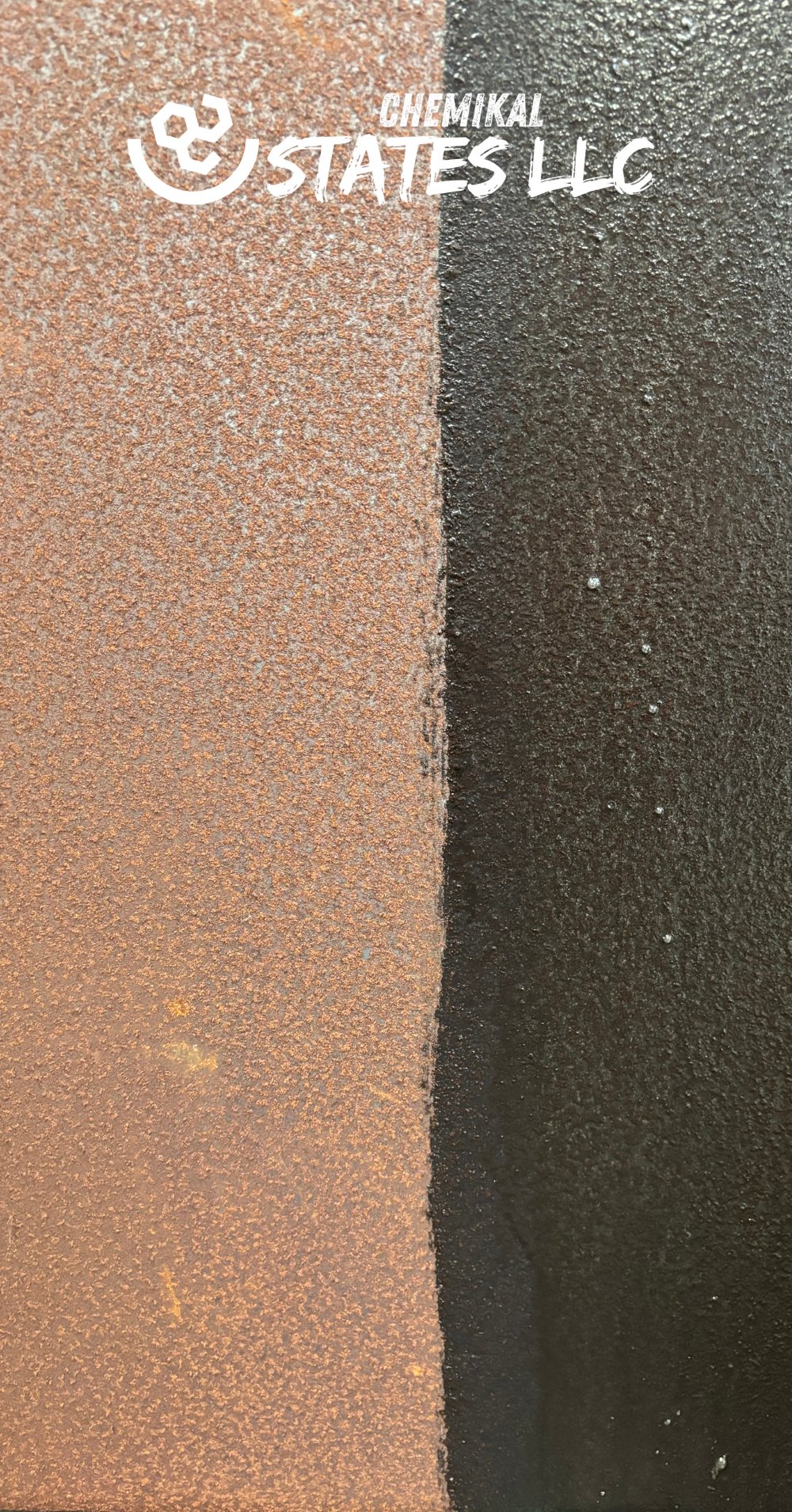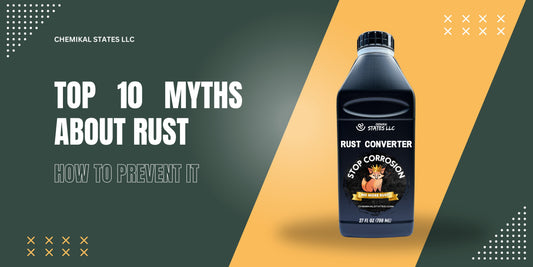
Rust Converter vs. Rust Remover: Which is Better for Your Project?
Share
When it comes to dealing with rust, two of the most popular products on the market are Rust Converters and Rust Removers. Both are designed to combat rust, but they operate in very different ways. Understanding the differences between these products is crucial for choosing the right one for your specific project. In this article, we'll compare Rust Converters and Rust Removers, discussing their pros and cons to help you make an informed decision.
What is a Rust Converter?
A Rust Converter is a chemical solution that neutralizes rust by converting it into a stable, paintable surface. This product works by chemically altering the rust (iron oxide) into a compound called iron tannate, which is inert and non-corrosive. A Rust Converter also often includes an organic polymer that forms a protective layer over the converted rust, creating a solid foundation for painting or coating.
Pros of Rust Converters
- Stops Rust in Its Tracks: Rust Converters halt the progression of rust by neutralizing it, preventing further corrosion.
- Prepares Surface for Painting: The conversion process creates a stable, paint-ready surface, making it easy to apply a protective coating afterward.
- Easy to Use: Applying a Rust Converter is straightforward and requires minimal preparation. Simply clean the surface of loose rust and debris, and apply the product directly to the rusted area.
- Long-Term Protection: By forming a protective barrier, Rust Converters offer long-term protection against future rusting, making them ideal for metal surfaces exposed to moisture and the elements.
Cons of Rust Converters
- Not a Rust Remover: Rust Converters do not remove rust but instead chemically change it. The treated area may retain a dark, textured appearance, which could be a downside if a smooth finish is desired.
- Limited to Rusty Surfaces: Rust Converters are specifically designed to work on rusty metal. They are not effective on clean, rust-free surfaces or non-ferrous metals like aluminum.
What is a Rust Remover?
A Rust Remover is a chemical product designed to dissolve and remove rust from metal surfaces. Rust Removers typically contain acidic compounds such as phosphoric or hydrochloric acid, which react with the rust to break it down and remove it from the metal. Once the rust is dissolved, the metal is left bare, ready for further treatment, such as priming and painting.
Pros of Rust Removers
- Completely Removes Rust: Rust Removers are highly effective at stripping away rust, leaving behind clean, bare metal.
- Ideal for Restoration Projects: If you're working on a restoration project where you need to return the metal to its original condition, a Rust Remover is the way to go.
- Works on Detailed Areas: Rust Removers are great for intricate parts, tools, and objects where you need to reach all areas of rust, including tight spaces and crevices.
Cons of Rust Removers
- Labor-Intensive: Using a Rust Remover often requires significant effort, including scrubbing, rinsing, and drying, which can be time-consuming.
- Exposes Metal to New Rust: After the rust is removed, the metal is left unprotected and can quickly start to rust again if not immediately coated with a protective layer.
- Hazardous Chemicals: The acids in Rust Removers can be harsh and potentially hazardous to handle, requiring protective gear and careful disposal.
Rust Converter vs. Rust Remover: Which Should You Choose?
Choosing between a Rust Converter and a Rust Remover depends on your specific project needs and the condition of the metal you're working with. Here are some scenarios to help you decide:
Choose a Rust Converter if:
- You Want to Stop Rust Quickly: If you're looking to halt the progression of rust and prevent further damage, a Rust Converter is the best choice. It neutralizes rust and forms a protective layer, making the metal surface ready for painting.
- You Need a Low-Maintenance Solution: Rust Converters are easy to apply and don't require extensive scrubbing or preparation. This makes them ideal for larger surfaces or projects where time and effort are a concern.
- You Plan to Paint Over the Surface: If your project involves painting the treated area, a Rust Converter creates a stable, paint-ready surface that ensures good adhesion and a long-lasting finish.
Choose a Rust Remover if:
- You Need to Completely Eliminate Rust: For projects that require removing all traces of rust and restoring the metal to its original condition, a Rust Remover is the right tool. It removes rust entirely, leaving a clean surface for further treatment.
- You're Working on Small or Detailed Items: Rust Removers are effective at reaching small, intricate areas where complete rust removal is necessary.
- You’re Preparing Metal for Repair: If your project involves welding, filling, or other types of metal repair, starting with a rust-free surface is crucial. A Rust Remover will ensure the metal is clean and ready for these processes.
Combining Both Products
In some cases, you may find that using both a Rust Remover and a Rust Converter is the best approach. For instance, you might start with a Rust Remover to eliminate heavy rust and follow up with a Rust Converter to treat any remaining spots and prepare the surface for painting. This combined approach can provide comprehensive rust treatment and long-term protection.
Why Choose Chemikalstates.com Rust Converter?
If you've decided that a Rust Converter is the right choice for your project, consider using the high-quality Rust Converter available at Chemikalstates.com. Our Rust Converter is designed to deliver outstanding results, making rust treatment simple and effective. By neutralizing rust and creating a protective layer, our product helps you preserve and extend the life of your metal surfaces with minimal effort.
Key Features:
- Easy Application: Apply directly to rusted areas with minimal preparation required.
- Long-Lasting Protection: Our formula not only stops rust but also protects the surface from future corrosion.
- Affordable Shipping: We offer reliable shipping at a flat rate of just $7, so you can get the products you need without breaking the bank. Learn more about our shipping policy here.
Get Expert Help and More Information
If you have any questions or need assistance choosing the right product for your project, don't hesitate to reach out to our team. Visit our Contact Page to get in touch with us. We're here to help you make the best choice for your rust treatment needs.
For more detailed information on rust converters and how they can benefit your specific projects, check out our in-depth blog on vehicle rust protection: Best Rust Neutralizer for Trucks and Vans.
When it comes to protecting and restoring your metal surfaces, making the right choice between a Rust Converter and a Rust Remover is key to achieving the best results. Whether you’re halting rust in its tracks or removing it entirely, Chemikalstates.com has the products you need to get the job done right.










